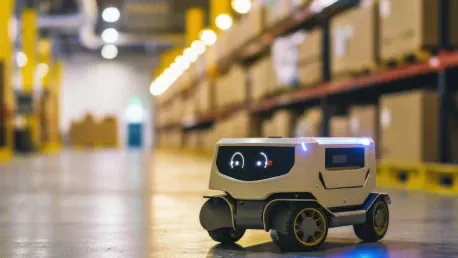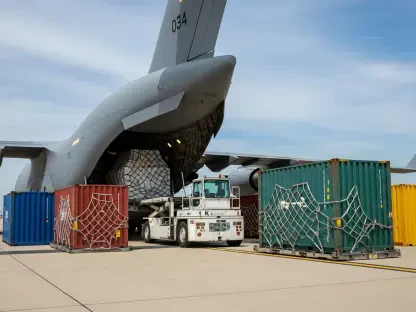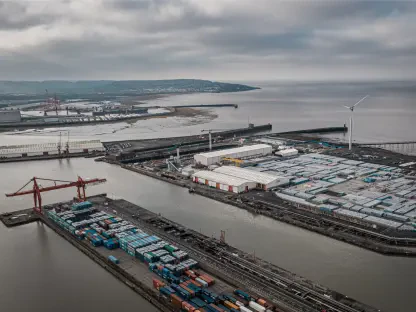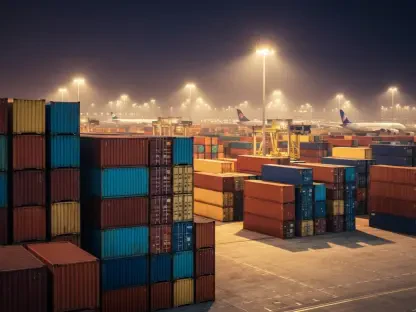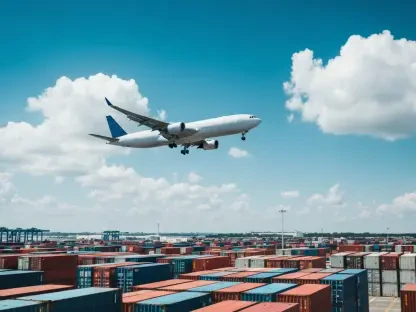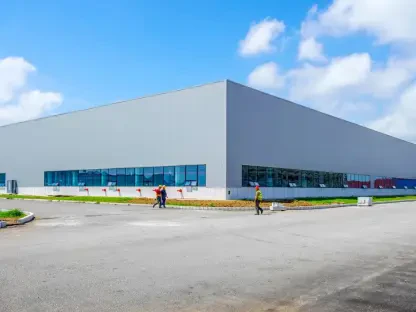The dynamics of global supply chains today demand that warehouses stand as paragons of reliability and efficiency, particularly within a landscape characterized by increased volatility. The proliferation of enterprise Internet of Things (IoT) technology has significantly contributed to making warehouse automation not only a feasible option for large corporations but also an accessible and appealing solution for small and medium-sized businesses striving to maintain competitiveness. As of 2024, it is remarkable to note that over 25% of all warehouses have adopted some form of automation, marking a substantial increase from a decade ago. This growth trajectory underscores IoT’s pivotal role in aligning warehouse operations with critical factors such as speed, accuracy, and adaptability.
Real-time Visibility
IoT and Smart Devices
IoT has revolutionized warehouse operations by enabling unprecedented real-time visibility. Through the integration of smart devices embedded within transport containers, products, and packaging, warehouses can continuously track facility metrics and implement advanced inventory management solutions. These connected devices offer unparalleled insights into stock levels, routes, and handling procedures, ensuring that warehouses operate with the kind of precision and reliability that modern supply chains demand. The seamless exchange of data among these devices facilitates immediate and informed decision-making, allowing warehouse managers to maintain optimal operational efficiency and mitigate potential disruptions before they escalate.
Asset Tracking Technologies
Central to this framework of enhanced visibility are a suite of sophisticated asset tracking technologies that include RFID tags, Bluetooth beacons, hybrid GPS-beacon systems, and mesh networks. RFID tags, combining microchips and antennas, allow for efficient tracking of inventory items by transmitting data to strategically placed readers throughout the warehouse. Bluetooth beacons contribute to continuous tracking by eliminating the bottlenecks associated with manual scanning, enabling uninterrupted communication between devices. Moreover, hybrid GPS-beacon systems and mesh networks significantly extend the accuracy and coverage of asset tracking, especially across expansive warehouse facilities. These technologies, working in harmony, create a robust and comprehensive tracking infrastructure that ensures precise real-time data on the location and status of assets.
Smarter Storage and Retrieval
Optimized Placement and Retrieval
IoT optimizes the placement and retrieval of goods within warehouses by delivering precise data about various parameters, such as location, quantity, and quality. This optimization is achieved through seamless integration with enterprise networks and Advanced Storage and Retrieval Systems (AS/RS), which harness data-driven management strategies to reduce the need for manual identification and minimize errors. By leveraging this real-time data, warehouses can ensure that goods are stored in optimal locations, facilitating faster retrieval processes and reducing the likelihood of misplaced items. Furthermore, the intelligent automation of storage and retrieval processes enhances overall efficiency and accuracy, leading to lower operational costs and improved service levels.
Specialized Storage Solutions
For warehouses dealing with specialized and fragile items, IoT technologies such as RFID, infrared sensors, and machine vision systems provide tailored storage solutions. These technologies enable careful monitoring and handling, preserving the integrity of sensitive goods throughout the supply chain. Infrared sensors, for instance, can detect precise environmental conditions to maintain suitable storage environments. Additionally, unified IoT platforms enhance worker safety by detecting human presence and analyzing behavior in real-time, triggering immediate alerts for any potential hazards. By combining these advanced technologies, warehouses can ensure secure and efficient storage while prioritizing worker safety and operational integrity.
Inventory Movement Monitoring
Precision Tracking
The application of smart sensor networks in warehouses has brought about a level of precision in inventory movement tracking that was previously unattainable. Connected devices affixed to goods provide continuous real-time location and status data directly to warehouse management platforms, ensuring comprehensive oversight of all inventory movements. This precise tracking capability not only enhances transparency within the warehouse but also enables more effective management of inventory flow and stock levels, thereby mitigating the risk of overstocking or stockouts. With accurate and timely data at their disposal, warehouse managers can make strategic decisions that improve overall operational efficiency and maintain a competitive edge in a fast-paced market.
Advanced Monitoring Systems
Advanced monitoring systems further elevate the effectiveness of inventory movement tracking by enabling simultaneous observation of stock levels, movement patterns, and order fulfillment processes. These sophisticated systems leverage the real-time data generated by IoT devices to forecast demand shifts and enable rapid responses to market changes, ensuring that supply chains remain agile and resilient. By understanding movement patterns and order fulfillment trends, warehouses can better align their operations with customer demands and market conditions, making proactive adjustments to optimize performance. The integration of such advanced systems thus plays a critical role in maintaining a smooth and efficient supply chain, ultimately leading to higher levels of customer satisfaction and business success.
Environmental Condition Tracking
Critical Condition Monitoring
In the realm of environmental condition tracking, smart sensor arrays are employed to meticulously monitor vital parameters such as temperature, humidity, and air quality within warehouse storage areas. This level of critical condition monitoring is especially vital for industries dealing with pharmaceutical products or perishable goods, where maintaining precise environmental conditions is paramount to preserving product quality and safety. IoT-enabled sensors provide continuous real-time data, allowing warehouse managers to ensure that storage conditions remain within optimal ranges. By doing so, they can prevent product spoilage, reduce waste, and safeguard the integrity of sensitive items, ultimately leading to more reliable supply chain operations.
Geofencing Technology
Geofencing technology adds an extra layer of security to warehouse operations by creating virtual boundaries around designated areas. When combined with IoT, geofencing allows warehouses to raise alerts for any unauthorized movements, providing proactive protection against potential security breaches. This enhanced security measure not only helps prevent the loss of valuable inventory but also ensures that products remain within controlled environments that meet specific storage requirements. By leveraging geofencing in conjunction with environmental condition tracking, warehouses can maintain stringent control over their operations, ensuring that all parameters are precisely managed to protect the integrity and quality of their inventory.
Advanced Automation and AI Integration
AI-Powered Predictive Analytics
The next phase in the evolution of warehouse automation involves the seamless integration of AI-powered predictive analytics with IoT systems. By processing the high-quality, redundant data generated by IoT devices, AI technologies can provide insightful performance analytics that enhance various aspects of warehouse operations. From optimizing storage space and streamlining picking routes to managing supplier performance more effectively, AI-powered analytics offer transformative benefits. This integration allows warehouses to move beyond reactive decision-making, enabling them to anticipate potential issues and proactively address them, leading to improved efficiency and productivity across the entire operation.
Precise Forecasting and Optimization
AI-driven techniques also play a crucial role in facilitating precise forecasting for storage and material handling systems, contributing to streamlined warehouse efficiency. By leveraging advanced algorithms and machine learning models, AI can analyze historical data and identify patterns and trends that inform better decision-making. This predictive capability allows warehouses to accurately forecast demand, optimize inventory levels, and allocate resources more efficiently. The result is a more responsive and adaptive supply chain that can quickly adjust to changing market conditions and customer needs, ensuring that warehouses remain competitive and capable of delivering high levels of service.
Human-Machine Collaboration
Augmenting Human Capabilities
Contrary to the widespread concern that advances in IoT and automation technologies might lead to job displacement, the latest wave of IoT in logistics is fundamentally designed to augment human capabilities rather than replace them. Technologies such as IoT-powered wearables, collaborative robots (cobots), and machine vision systems exemplify this trend by enhancing the productivity and safety of human workers. These tools are engineered to work alongside humans, reducing training times and enabling workers to perform tasks more efficiently and accurately. By augmenting human capabilities with advanced technology, warehouses can achieve higher levels of productivity without significant disruptions to existing processes or workforce dynamics.
Enhancing Productivity and Safety
The collaborative nature of IoT-powered technologies and cobots ensures that human workers are not only more productive but also safer in their daily operations. Wearables equipped with IoT capabilities can monitor worker health and safety in real-time, providing alerts for potential hazards or unsafe conditions. Cobots, designed to work in tandem with humans, can perform repetitive or physically strenuous tasks, reducing the risk of workplace injuries. Meanwhile, machine vision systems can assist in quality control and ensure that processes are carried out with precision. By fostering a harmonious collaboration between humans and machines, warehouses can optimize their operations while prioritizing worker well-being and safety.
Future Prospects: Digital Twins and More
Digital Twin Technology
Looking ahead, one of the most promising technological advancements in warehouse automation is the concept of digital twins. Digital twins create virtual replicas of physical warehouses, allowing for risk-free testing of optimization strategies and scenario planning. This technology enables warehouse managers to simulate various configurations and operational changes without disrupting actual workflows, providing valuable insights into potential outcomes. By leveraging digital twin technology, warehouses can optimize processes, improve efficiency, and reduce costs while minimizing the risk of errors and operational disruptions.
Expanding Across Supply Chains
The future potential of digital twin technology extends beyond individual warehouses to encompass entire supply chains. By expanding digital twins across supply chains, companies can refine route optimization, inventory distribution, and workforce allocation on a larger scale. This holistic approach enables more comprehensive simulations and dynamic adjustments to supply chain operations, ultimately enhancing overall efficiency and responsiveness. Additionally, the integration of large language models (LLMs) promises further advancements by enabling extensive scenario simulation and real-time adaptation to changing conditions. The continuous evolution of digital twin technology and its expansion across supply chains hold the promise of transforming warehouse operations and supply chain management in profound ways.
Future-Proofing IoT Infrastructure
Robust IoT Infrastructure
To fully realize the benefits of advanced warehouse automation, a robust and scalable IoT infrastructure is essential. This infrastructure must be capable of integrating and supporting emerging technologies, ensuring that warehouses can adapt to evolving demands. Scalability and a flexible data processing architecture are critical components, with cloud platforms playing a pivotal role in managing variable data loads efficiently. By investing in a strong IoT infrastructure, warehouses can maintain peak system performance and ensure that they are well-equipped to leverage future technological advancements.
Continuous Improvement
In today’s global supply chain environment, warehouses must exemplify reliability and efficiency, especially in the face of growing uncertainties. The introduction and spread of enterprise Internet of Things (IoT) technology have remarkably advanced warehouse automation. Now, such automation is not just within the reach of large corporations but also an attractive and viable option for small and medium-sized businesses seeking to remain competitive. By 2024, it’s noteworthy that over 25% of all warehouses will have adopted some form of automation, a significant rise from ten years prior. This trend highlights IoT’s crucial role in enhancing warehouse operations by aligning them with essential factors such as speed, accuracy, and adaptability.
Moreover, IoT technology has allowed for more sophisticated tracking and monitoring systems, optimizing inventory management, and reducing losses. Automated systems can now predict demand, streamline supply processes, and even tailor warehouse environments to specific needs, ultimately reducing costs and improving service quality. The integration of IoT in warehouses marks a transformative shift, making operations more responsive to the dynamic market demands and ensuring that businesses can navigate fluctuations more effectively. By enhancing the fundamental aspects of warehouse management, IoT stands as a cornerstone technology driving the future of supply chain logistics.
